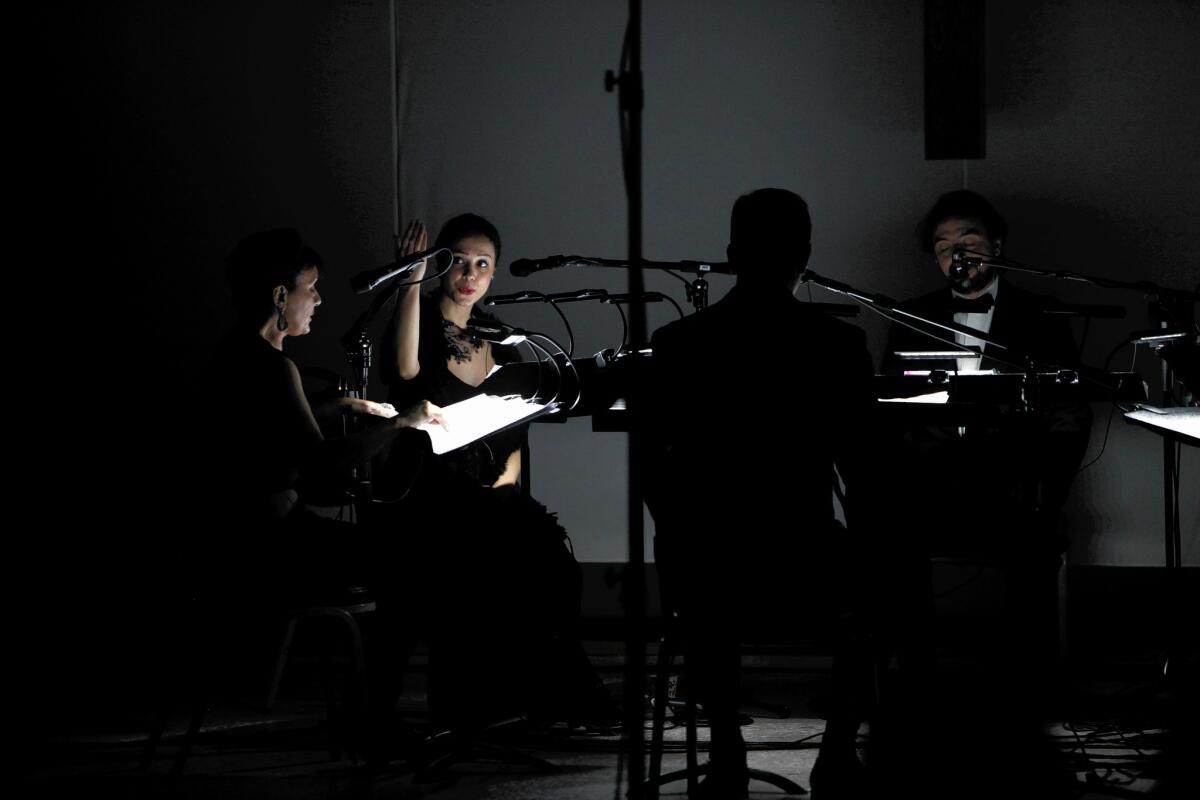Review: Serenity in this ‘Stimmung’ soothes far-out sounds of the ‘60s

In Karlheinz Stockhausen’s wondrous, strange “Stimmung,” six singers sit in a circle, produce otherworldly harmonics, evoke the names of Aztec gods, intone an eccentric hallelujah chorus and interrupt transcendental meditation reciting texts with graphic sexual imagery. There was nothing like it when the visionary German composer wrote “Stimmung” (which translates as tuning and is similar to the word for voice) holed up in a cabin with his new wife in Connecticut the winter of 1968. There is now, and that is only because “Stimmung” was, and remains, a phenomenon.
Saturday night “Stimmung” was sung in Santa Monica at First Presbyterian Church by a new vocal ensemble called Voxnova, founded in Rome last year by the American baritone Nicholas Isherwood and making its international debut in the new music series Jacaranda. The Voxnova “Stimmung” was unusual — stunningly beautiful, utterly serene, full of charm and doing everything it could to avoid embarrassment.
The history of “Stimmung” is ever recountable, and Jacaranda made it more so by inviting Stockhausen’s widow and “Stimmung” muse, the German artist Mary Bauermeister, to attend the performance and give talks in Los Angeles. As Bauermeister has described, “Stimmung” may be a landmark in German music, but its basis is our West Coast.
CRITICS’ PICKS: What to watch, where to go, what to eat
In 1967, Stockhausen, who had come to California to teach for a year at UC Davis, became turned on by the Bay Area psychedelic culture. The Summer of Love, he married Bauermeister, whose atelier in Cologne had been a gathering place for the avant-garde, in Sausalito — a wedding that had to be postponed, Bauermeister recently explained, because upon arriving in Marin County she had spontaneously made love with Stockhausen outdoors in a bed of poison ivy.
Written a few months later and after the birth of the couple’s son, Simon, “Stimmung” captures aspects of the sound of breathing — a baby’s breath, a composer’s internal breath, lovers’ breaths. To do so, Stockhausen turned to ancient techniques — exploited by Tibetans, Tuvans, Inuits and other cultures — of producing multiple pitches.
The Aztec connection, in case you are wondering, came about from a trip to Mexico. Bauermeister explained that Stockhausen, who had a lifelong tendency toward polygamy, told her shortly after their marriage that he had a girlfriend there he needed to spend time with exploring ruins.
The first recording by Collegium Vocale Cologne, made in 1969, was a sensation. Listeners couldn’t believe their ears hearing vowel sounds magically burst into unexpected whistles and other high frequencies. Those gods seemed physical aural presences emanating from record players. The combination of the mystical and earthily erotic, of course, was no stretch in the ‘60s counterculture, but no one had done it like that before.
ART: Can you guess the high price?
The version of “Stimmung” that Isherwood, who worked for many years with Stockhausen up to the composer’s death in 2007, produced is a purified “Stimmung.” Singers have become adept at producing overtones without needing vowels to trigger them. The gods have become optional. And the Italians make the sexual poetry sound suave, not disquieting.
In fact, nothing was disquieting in the ethereal and unusually short 50-minute performance (75 minutes is common). The voices blended as smoothly as if this were an Italian madrigal. Bel canto Stockhausen is a peculiar concept, perhaps, but to err on the side of beauty is no terrible thing. The voices here might have been angels.
The program began with cellist Timothy Loo playing “Nomos Alpha” by Iannis Xenakis. Written three years before “Stimmung,” it asks the cellist for the impossible, which Loo delivered in an astonishing performance.
There are passages that can’t be played without rubbing the skin from fingers. There are passages that can’t be played by two-handed cellists.
PHOTOS: Arts and culture in pictures by The Times
Loo has found solutions. He uses a white glove to protect his left hand. He has new electronics that help him get through the three-handed measures. (When he performed it at Jacaranda five years ago, he had the help of a second cellist.)
Much more important is the drama Loo brings to another wondrous strange score. The Greek composer was known for the mathematic rigor of his compositional methods. Loo made elaborate finger-work sing. He made aggressive bowing into raw theater. He made space-age glissandos something felt in your stomach.
There has been a lot of foolish talk in new music circles lately about the dryness of the ‘60s avant-garde. Jacaranda on Saturday night revived the era’s wow factor.
More to Read
The biggest entertainment stories
Get our big stories about Hollywood, film, television, music, arts, culture and more right in your inbox as soon as they publish.
You may occasionally receive promotional content from the Los Angeles Times.











